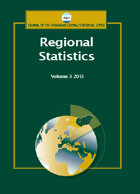Territorial indicators for policy purposes: NUTS regions and beyond
Territorial indicators for policy purposes: NUTS regions and beyond
Author(s): Teodora Brandmüller, Schäfer Gunter, Ekkehard Petri, Müller Oliver, Angelova-Tosheva ValeriyaSubject(s): Social Sciences, Economy, Geography, Regional studies
Published by: Központi Statisztikai Hivatal
Keywords: NUTS;Cohesion Policy; urban-rural classification; population grid;
Summary/Abstract: Regional statistics, along with the NUTS (Nomenclature des Unités Territoriales Statistiques, or Nomenclature of Territorial Units for Statistics) classification, already have a solid tradition. They have developed into a very useful tool for detailed analyses and have become the basis for important decisions in the allocation of EU funding. Gradually, the scope of regional statistics has widened, and regional statistics now play a role in several statistical domains with a wide range of statistical indicators. The recognition that many of the social and economic issues Europe faces today have urban or rural characteristics has led to an initiative to supplement statistical data on NUTS regions with data on cities and rural areas. These sub-national statistics allow policy makers to better target their policies. For example, in some parts of Europe, poverty and social exclusion are clearly an urban problem, while in other areas they are primarily a rural problem. A further aspect that has gained considerable importance in territorial policy making—as well as in public awareness—concerns the so-called functional regions, which are selected or constructed from more detailed geographical units according to specific features. The labour market area is one example of this type of functional delineation, which helps to shed light on important territorial characteristics. The fast-growing use of geographic information and new technical facilities has created possibilities for merging statistics and related geographical information into so-called spatial statistics. An example is grid-based population data, which helps to determine the concrete locations of people with access to certain facilities (e.g. public transport, airports) or to identify a population close to the sea. Through the intensive use of map-related functions, the utility of regional and urban statistics can also be enhanced, and different statistics can be combined. This paper argues that different sub-national statistics offer different but interrelated perspectives. They can be combined in multiple ways to create new possibilities for policy analysis and to illustrate social and economic characteristics at varying levels of geographic detail.
Journal: Regional Statistics
- Issue Year: 7/2017
- Issue No: 01
- Page Range: 078-089
- Page Count: 12
- Language: English

